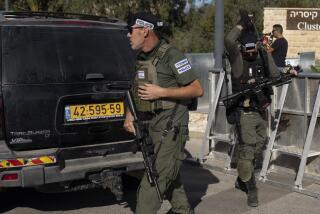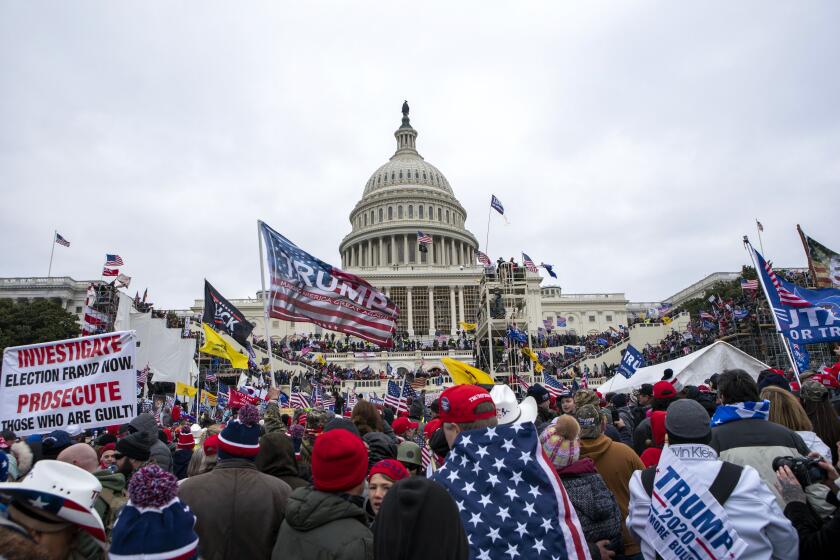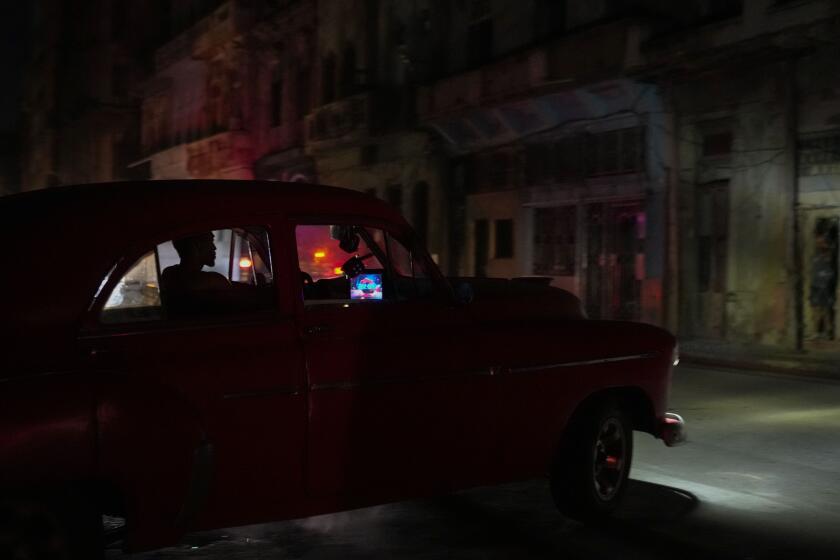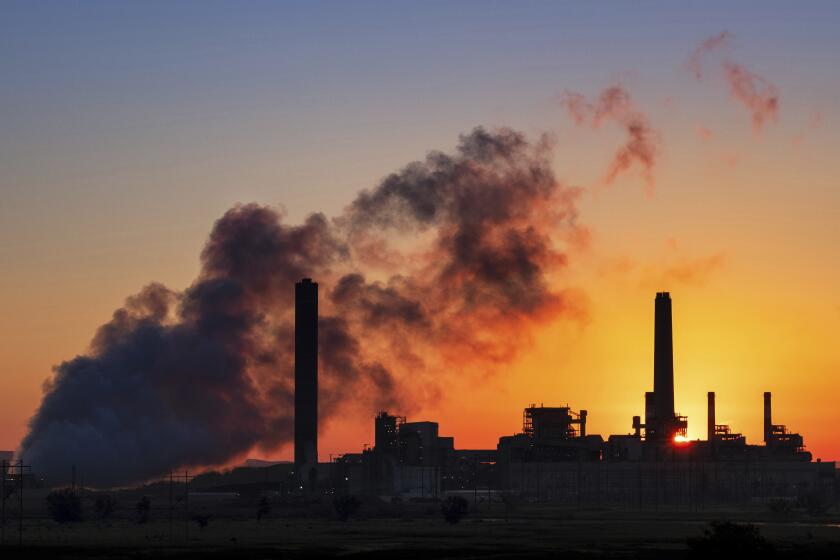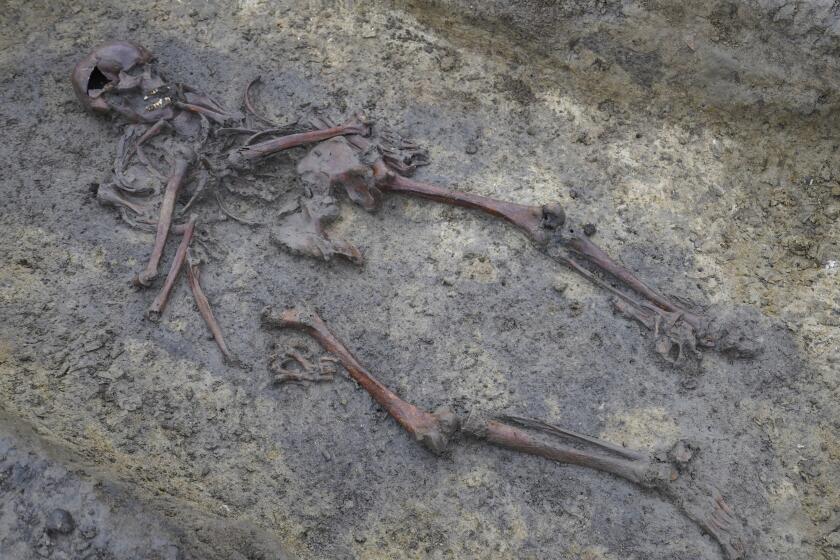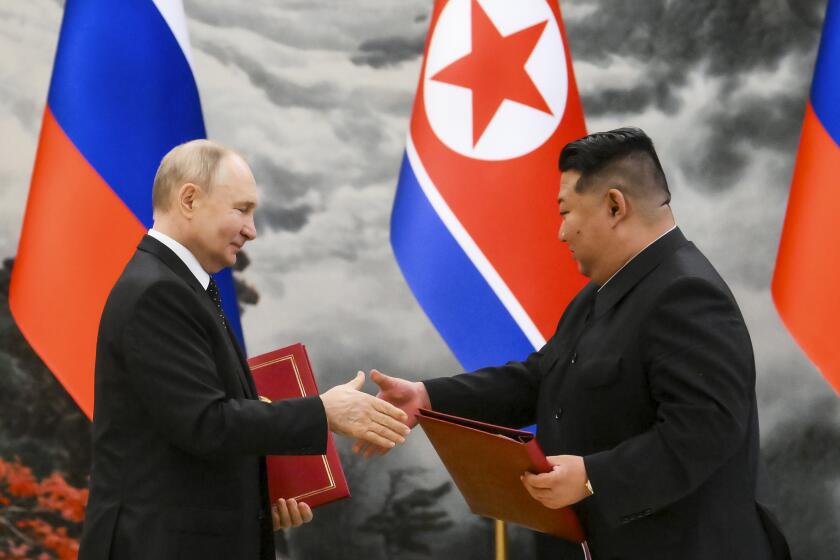U.S. Troops Clash With Insurgents, Kill 18 Iraqis
Violence flared in several Iraqi towns Tuesday and early today as U.S. troops clashed with insurgents, and defiant demonstrators in bastions of loyalty to the old regime protested the capture and treatment of Saddam Hussein.
From Baghdad through the Sunni Muslim-dominated belt of central Iraq that was Hussein’s power base, all the way to the northern city of Mosul, crowds took to the streets in anger or fought with U.S.-backed police.
In all, U.S. forces killed at least 18 Iraqis in a 24-hour period.
A truck laden with explosives detonated at 6:30 a.m. today in an apparent accident at a busy intersection in Baghdad, killing 10 people and injuring 15, police official Ahmed Ibrahim said.
Two other explosions were reported during Baghdad’s morning rush hour, but there was no immediate word of casualties.
Here in Fallouja, west of Baghdad, rioters on Tuesday blew up the offices of the U.S.-appointed mayor, fired rocket-propelled grenades at American forces and attacked a train carrying U.S. military supplies. Seven Iraqis were reported killed here and in nearby Ramadi when U.S. forces opened fire.
In Tikrit, Hussein’s hometown, three U.S. soldiers were wounded by a roadside bomb.
And in one extended ambush Monday in Samarra, U.S. officials said, insurgents signaled the approach of a U.S. Army patrol by giving flight to a flock of carrier pigeons, then used schoolchildren as cover to open fire. American forces killed 11 Iraqis in that incident, the U.S. military said Tuesday. No Americans were reported among the casualties.
In the wake of the ambush, the Army raided a village near Samarra early Tuesday and took more than 70 people into custody, including a man described as a rebel commander and financier of guerrilla operations, officials said. It was not immediately clear whether the man, Qais Hattem, was involved in Monday’s attack or an especially intense fight last month in Samarra that the U.S. said left 54 Iraqis dead.
This morning, U.S. troops launched a major offensive dubbed Ivy Blizzard in Samarra, a city of 200,000, sealing it off and searching for insurgents.
Although Tuesday’s demonstrations were not remarkably large, the tenacity of continued opposition -- armed and unarmed -- to the U.S.-led occupation complicates the Bush administration’s mission and dispels any notion that peace is at hand after Hussein’s arrest.
At the same time, other Iraqis staged peaceful but emotional celebrations in the Shiite Muslim-dominated south and in downtown Baghdad.
U.S. officials expressed optimism that even if violence surged in the short term, it would subside as the reality of Hussein’s arrest set in.
Air Force Gen. Richard B. Myers, chairman of the Joint Chiefs of Staff, made an unannounced stop in Baghdad on Tuesday and told reporters that he believed the capture of Hussein would hurt the insurgency.
“When you take this leader ... and find him in a hole in the ground, then that’s a powerful signal you may be on the wrong team and maybe you need to be thinking about some other line of work, which is building a new Iraq,” Myers said at the Baghdad airport. “Leadership from a hole is not leadership.”
Standing at his side, Lt. Gen. Ricardo Sanchez, commander of coalition forces in Iraq, said it would take some time for the effect of Hussein’s arrest to be felt.
In downtown Baghdad, several hundred Shiite demonstrators waving banners praising God celebrated the capture Saturday of the former president.
“We come to claim our rights in executing Saddam because he cannot stay alive on the face of this Earth,” said Hussein Mosayi, a 65-year-old cleric.
“The Iraqi people should decide how Saddam should be executed,” said Ginan Ibrahim, 28, one of the few women at the rally. “Either we cut off his head or cut him to pieces.”
A similar demonstration arranged by Shiite political parties took place in Basra, far to the south. The long-repressed Shiites, along with the Kurds of the north, are among the Iraqis who have reveled most in Hussein’s capture.
The picture was different in areas of lingering loyalty to the ousted dictator and heightened anger over the U.S. occupation.
In Baghdad’s Amiriyah neighborhood, where former intelligence agents live, several dozen men in their late teens waved photos of the ex-president and shoved their Hussein-emblazoned T-shirts in the faces of an American patrol.
After nightfall Tuesday in another Baghdad neighborhood dominated by Sunni Muslims, Adhamiya, gunmen shot at and torched a passing U.S. Army vehicle and troops returned fire, witnesses said. The area has had numerous pro-Hussein rallies in recent days.
“There are people who love Saddam but many who don’t,” said a former Iraqi army major who gave his name as Abu Ahmed. “All of this is happening because America’s promises have not been delivered.”
In Mosul, where attacks against Americans have recently escalated, students outside the university chanted for the release of Hussein and excoriated the occupation authority.
“The Americans only want to steal our natural resources,” said Alaa Faris, 35. “If Saddam assumes power again, he will burn them like coal.” The demonstration turned violent and one policeman was killed, authorities said.
In Fallouja, businessman Fakhir Khalifa Mohammed, who watched American armor roll into town to quell two days of rioting, said residents were most angry about the videotape of Hussein submitting to a medical exam. In it, an American doctor seemed to inspect his hair for lice and poked his mouth with a tongue depressor.
“Humiliating, an insult and an indignity,” he said.
Mohammed predicted that the pro-Hussein demonstrations would peak and die out. The resistance, however, is fueled by Islamic fervor and lives independent of the man who ruled the nation for more than two decades, he said, and he expected that to grow and become more aggressive.
The rioters in Fallouja overran the headquarters of the U.S.-appointed mayor, ransacked it and blew it up. Then they set fire to the offices of two political parties that surfaced after the U.S. takeover. Under Hussein, only the Baath Party was legal.
Tensions were high Tuesday afternoon. Rioters attacked and pillaged a U.S. supply train. U.S. fighter jets swooped low and repeatedly buzzed the city in what the Army called a show of force. Residents stood staring at the aircraft; a line of schoolgirls ducked their heads and rushed home.
As for the ambush in Samarra, guerrilla scouts apparently alerted their comrades to the arrival of a 2nd Infantry Division patrol by sending a flock of carrier pigeons into the air. Moments later, gunmen on motorcycles opened fire with automatic weapons, using children leaving school as cover, said military spokesman Lt. Col. Bill MacDonald.
U.S. snipers were able to defend the patrol, which continued through the city. But the troops soon came under fire again, this time from gunmen hiding in an overgrown field.
Then a roadside bomb went off to the patrol’s south, mortar shells rained from the north and rocket-propelled grenades slammed in from the west.
The American forces were able to beat back the assault and escape unscathed, MacDonald said. Eleven Iraqis were killed.
*
Times staff writers Chris Kraul and Patrick J. McDonnell and special correspondent Salar Jaff in Baghdad contributed to this report.
More to Read
Sign up for Essential California
The most important California stories and recommendations in your inbox every morning.
You may occasionally receive promotional content from the Los Angeles Times.
